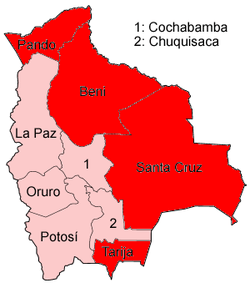Media Luna

The Media Luna (half moon) or Media Luna Ampliada (extended half-moon) refers to a group of four departments – Santa Cruz, Beni, Pando, and Tarija – in Bolivia which became the geographic area of opposition to the national government led by Evo Morales and the Movement for Socialism (MAS).
Overview
The name comes from the general crescent shape made by the four departments. The term media luna was coined soon after the election of Evo Morales to designate the mostly eastern-located departments that objected to the nationalization and redistribution of natural gas that is a major natural resource in the region and the policy of land reform that would be most vigorously enacted in those regions. The prefects of Santa Cruz, Beni, and Tarija elected in the December 2005 elections all hailed from Bolivian opposition parties. These governors formed the National Council for Democracy (CONALDE). In 2008, these departments were the major areas of violence between supporters of the national government and supporters of autonomy for the departments.
The list of media luna departments was extended by some observers to include the departments of Cochabamba and Chuquisaca in 2007 and 2008. Cochabamba's prefect, Manfred Reyes Villa endorsed the other media luna governors' proposals for departmental autonomy. In June 2008, opposition member Savina Cuéllar was elected as Prefect of Chuquisaca, marking a high point of opposition power. However in the 2008 recall referendum, Reyes Villa was recalled. In Chuquisaca as well as Tarija, Morales enjoyed majority support in the 2008 referendum only in the rural areas, while the capital cities (Sucre and Tarija respectively) had a majority for recalling Morales.[1] Following the Porvenir Massacre, Pando's opposition prefect Leopoldo Fernández, who was arrested and detained for his suspected involvement in the massacre of at least 20 peasants, was replaced by an interim prefect from the military in September 2008.